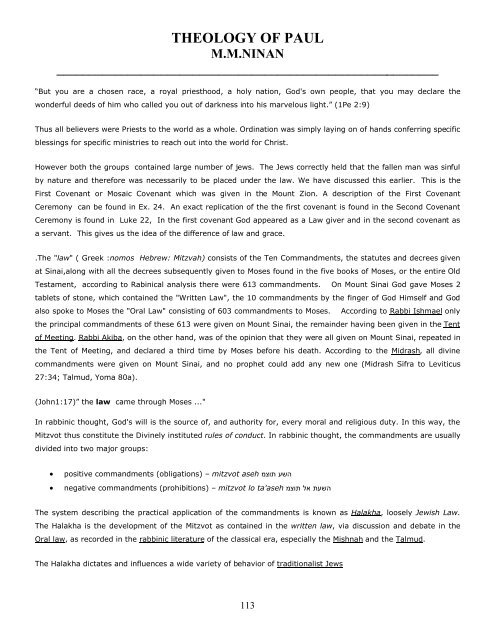Theology Of Paul
Create successful ePaper yourself
Turn your PDF publications into a flip-book with our unique Google optimized e-Paper software.
THEOLOGY OF PAUL<br />
M.M.NINAN<br />
___________________________________________________________<br />
“But you are a chosen race, a royal priesthood, a holy nation, God's own people, that you may declare the<br />
wonderful deeds of him who called you out of darkness into his marvelous light.” (1Pe 2:9)<br />
Thus all believers were Priests to the world as a whole. Ordination was simply laying on of hands conferring specific<br />
blessings for specific ministries to reach out into the world for Christ.<br />
However both the groups contained large number of jews. The Jews correctly held that the fallen man was sinful<br />
by nature and therefore was necessarily to be placed under the law. We have discussed this earlier. This is the<br />
First Covenant or Mosaic Covenant which was given in the Mount Zion. A description of the First Covenant<br />
Ceremony can be found in Ex. 24. An exact replication of the the first covenant is found in the Second Covenant<br />
Ceremony is found in Luke 22, In the first covenant God appeared as a Law giver and in the second covenant as<br />
a servant. This gives us the idea of the difference of law and grace.<br />
.The "law" ( Greek :nomos Hebrew: Mitzvah) consists of the Ten Commandments, the statutes and decrees given<br />
at Sinai,along with all the decrees subsequently given to Moses found in the five books of Moses, or the entire Old<br />
Testament, according to Rabinical analysis there were 613 commandments. On Mount Sinai God gave Moses 2<br />
tablets of stone, which contained the "Written Law", the 10 commandments by the finger of God Himself and God<br />
also spoke to Moses the "Oral Law" consisting of 603 commandments to Moses. According to Rabbi Ishmael only<br />
the principal commandments of these 613 were given on Mount Sinai, the remainder having been given in the Tent<br />
of Meeting. Rabbi Akiba, on the other hand, was of the opinion that they were all given on Mount Sinai, repeated in<br />
the Tent of Meeting, and declared a third time by Moses before his death. According to the Midrash, all divine<br />
commandments were given on Mount Sinai, and no prophet could add any new one (Midrash Sifra to Leviticus<br />
27:34; Talmud, Yoma 80a).<br />
(John1:17)” the law came through Moses ..."<br />
In rabbinic thought, God's will is the source of, and authority for, every moral and religious duty. In this way, the<br />
Mitzvot thus constitute the Divinely instituted rules of conduct. In rabbinic thought, the commandments are usually<br />
divided into two major groups:<br />
השע תוצמ • positive commandments (obligations) – mitzvot aseh<br />
השעת אל תוצמ • negative commandments (prohibitions) – mitzvot lo ta'aseh<br />
The system describing the practical application of the commandments is known as Halakha, loosely Jewish Law.<br />
The Halakha is the development of the Mitzvot as contained in the written law, via discussion and debate in the<br />
Oral law, as recorded in the rabbinic literature of the classical era, especially the Mishnah and the Talmud.<br />
The Halakha dictates and influences a wide variety of behavior of traditionalist Jews<br />
113


















